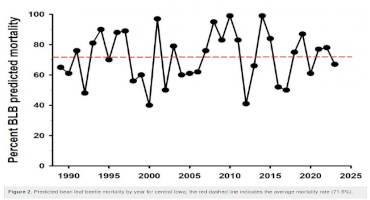We can estimate winter mortality based on accumulated sub-freezing temperatures using an overwintering survival model developed by Lam and Pedigo from Iowa State University in 2000. Predicted mortality rates vary across Iowa for the 2022-2023 winter, ranging from 43-99% (Figure 1). Mortality was highest in northern and central Iowa (92-99%); the average mortality rate across Iowa was 67% for the 2022-2023 winter.

Figure 1. Predicted overwintering mortality of bean leaf beetle based on accumulated subfreezing temperatures during the winter (October 1, 2022 – April 15, 2023).
These mortality predictions have been tracked since 1989. The predicted mortality of bean leaf beetle in central Iowa this winter was 72%, which is similar to the 35-year average of 71.6% (Figure 2). Insulating snow cover and crop residue can protect bean leaf beetle from harsh air temperatures, and variable snow and residue cover is not accounted for by the model. Fluctuating temperatures can negatively influence spring populations.

Figure 2. Predicted bean leaf beetle mortality by year for central Iowa; the red dashed line indicates the average mortality rate (71.6%).
Based on this model, we expect overwintering bean leaf beetle populations to be higher this year in all regions except northwest and west central Iowa. Because these populations are highly variable, it is important to scout for this pest. Scout soybean fields, especially if:
1. Soybean is planted near alfalfa fields or if the field has the first-emerging soybean in the area. Overwintering adults are strongly attracted to soybean and will move into fields with emerging plants.
2. Fields are planted to food-grade soybean production or are seed fields where reductions in seed quality can be significant.
3. Fields have a history of bean pod mottle virus.
Sampling early in the season requires you to be “sneaky” to accurately estimate densities as bean leaf beetles are easily disturbed and will drop from plants and seek shelter in soil cracks or under debris. For early season scouting, slowly walk down 15-20 feet of row and count beetles and plants. Repeat this in four more areas of the field and calculate beetles/plant. Economic thresholds range from 2 to 8 beetles/plant depending on crop value and control costs. Although overwintering beetles rarely cause economic damage, their presence may be an indicator of building first and second generations later in the season. Find an economic threshold table and more information on scouting for bean leaf beetle in this encyclopedia article, and learn more about bean pod mottle virus from the Crop Protection Network.
Source : iastste.edu